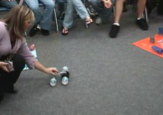 Why Not Email
Why Not Email
I hate email. While it is so easy to shoot off a quick email to someone, it is not always the most efficient way to manage or participate in collaborative projects.
In the beginning of MoNSteR MaTcH, I used email for everything. Registration was done by emailing me. Confirmations were emailed to the teachers. Teachers emailed descriptions to each other and copied me on those so I could keep track of them. I emailed other people to participate in their projects.
Many times not everyone is included on the email. Some people don’t have their email programs set to include the original text with the reply, so when I get the message, “Yes, that date and time will work for me” with no original text, I would have to begin the email excavation to try to determine the context.
Why Wikis
Currently, there are three different ways that we are using wikis to support projects. You will have to trust that the people running the project are really watching the wiki. Wikis are monitored by using RSS feeds or getting emails.
Weather Buddies (all one page project)
http://disdvideoconferencing.pbworks.com/Weather-Buddies
- Click edit.
- Use guest username and login.
- Add your details for you teachers.
- Click save.
- You will get a confirmation email when the project manager is notified that the wiki has been edited.
Goods & Service (need 5 classes) (one wiki project – participating classes)
http://goodsvc.wikispaces.com/
- Click Participating Classes
- If you see a spot that will work for one of your teachers, click “Join this Wiki” at the top left.
- Enter a comment. “I have a class that would like to participate in this project.” and click Request Membership.
- Once you have access to the wiki, go back to the participating classroom page. Click EDIT and add your teacher’s information. Click SAVE.
- You will get a confirmation email when the project manager is notified that the wiki has been edited.
Monster Match (page to edit)
http://www.monstermatchproject.com
Wikis ROCK for MoNSteR MaTcH because it helps me make sure all the descriptions are exchanged in a timely manner.
- Go to the Participating Classes page.
- Find your last name. Click it.
- Look at the top right and click the EDIT button.
- Copy your description from a word processing document and then paste it into the page.
- Click Save.
Kid2Kid Footer for each post
If you are totally new to collaborative projects and/or would like step by step assistance making a collaborative project happen, from start to finish, sign up for Kid2Kid Videoconference Connections, a six week online course beginning January 25.



 Next, think about how you will organize your participation:
Next, think about how you will organize your participation: